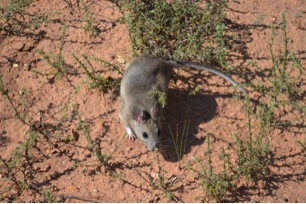Updated: 23/04/2025
Decades of ecological research have focused on interactions between herbivores and the chemical defenses of plants. However, far less is known about how effective physical defenses (spines, thorns, etc.) are against mammalian herbivores. It has been argued that co-evolution between plant physical defenses and herbivores might underly the confusing results across many studies.
Therefore, we conducted a study, now published Early View in Oikos “Evolutionary irony: evidence that ‘defensive’ plant spines act as a proximate cue to attract a mammalian herbivore”, focused on the interaction between the white-throated woodrat (Neotoma albigula) and the cactus on which it specializes. There is great variation in how heavily-defended the cactus plants are, ranging from almost spineless to very spiny in the area where we study these animals (Castle Valley, UT, USA),
Woodrats collect large amounts of plant material in their nests that they feed on later. Interestingly, we noticed that the woodrat nests were covered mostly in heavily defended, spiny cacti. This phenomenon caused us to ask whether woodrats preferred spiny cacti, and why that might be.
We performed a number of feeding trials and choice experiments to show that indeed, woodrats do prefer spiny cacti to experimentally despined cacti. This result suggested that woodrats use the cactus spines as a cue for feeding. Nutritional analysis revealed that spiny cacti are lower in indigestible fiber and higher in protein than spiny cacti. We hypothesize that the woodrats may be using the signals of spines to collect a more nutrient-rich plant that they then feed on later.
Our results demonstrate that physical defenses can be overcome by specialist mammalian herbivores. Further, they show that mammalian herbivores can use obvious, visual clues to select plants that they want to consume.
The authors, through Kevin Kohl




